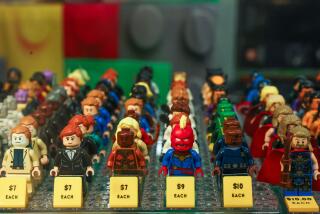WonderWorks: Model Masters of Illusion : Miniatures: Canoga Park firm makes replicas for movies, museums and NASA. Its latest is its 15th space shuttle project--a full-size, 45-foot-long version.
- Share via
CANOGA PARK — Every time NASA downsizes its space station project, aerospace contractors across the country cringe. But one company that could benefit is WonderWorks, a Canoga Park firm that builds models and designs special effects for film studios, museums and NASA.
Owned by Brick Price, WonderWorks has built half a dozen scale models of the Space Station Freedom for the National Aeronautics and Space Administration, which it uses for promotional purposes. The space agency’s latest redesign of the space station, because of cost-cutting by Congress, means that Price will likely be asked to build yet another model. The space station models are a few feet long.
WonderWorks’ last space station model contract a year ago brought it $30,000. That’s small potatoes even for a company like WonderWorks, which does about $1 million in annual sales. But it’s one of the many aerospace modeling projects that has kept WonderWorks humming, even while firms working on the real space station, such as nearby Rocketdyne, also in Canoga Park, are struggling.
WonderWorks also makes models for Rocketdyne and other aerospace firms. But lately Price has been benefiting from overseas demand for spacecraft models. Price is now finishing work on a full-size, 45-foot-long model of the space shuttle Endeavour, which will go on display at the Tama Children’s Museum in Japan. That is Price’s 15th space shuttle model, mostly done for foreign museums.
“Even though it’s a model, it looks so real,” said Masashi Yamamoto, director of Full House, a Tokyo public relations firm that commissioned Price to work on the $350,000 project. Yamamoto, who was visiting WonderWorks’ offices last week, said: “I’m really impressed in the finishes and detail of his work.”
WonderWorks isn’t limited to aerospace models. The 8-year-old company makes models of everything from miniature trains to giant ants. And these are often used for special effects in commercials and movies. Price built the miniature submarine and helicopter models for the movie “Abyss” and the robots used in Michael Jackson’s video “Moonwalker.”
Besides building space shuttle models, WonderWorks has carved a niche for itself by specializing in creating special effects using miniature models. By trick photography, Price can make miniature models look real. In a commercial for Keystone beer, for example, Price created a four-foot island idol and made it look 50 feet tall. And in a television ad for Borden, Price made a three-foot barn look real by placing it on top of a real white picket fence in a field in Simi Valley.
“I guess our business is one of creating illusions,” said Price, 47, who grew up building models.
The bearded Price has both artistic and scientific interests. Price’s father was a Caltech scientist, and his mother drew cartoons for Walt Disney. Price, a native of Pasadena, worked as an engineer for Hughes, and he drew cartoons while in the Army.
Price was publishing his own modeling magazine in 1977 when he met Gene Roddenberry, the creator of “Star Trek.” Roddenberry asked Price to make a model of the Enterprise, and that launched a new career for Price. He formed a business called Movie Miniatures, and its name was changed to WonderWorks in 1985.
Since then, Price’s clients have included major movie studios. Price says he built model trains and designed the fiberglass sign at the entrance to Jackson’s private amusement park, Neverland Valley Ranch.
Price’s models aren’t cheap. In fact, a model of a car can run as much as $35,000. Why would a car company pay that much for a model?
Price says it’s because a model often looks better on film. Plus there are other times when a real car can’t be used. For example, Mercury wanted to dip its car in a pool of mercury for a commercial. So Price built a 1/12th scale model of a Mercury. The cost: $17,000--comparable to a real Mercury.
Price is in a highly fragmented industry, and his competitors include Walt Disney and “Star Wars” filmmaker George Lucas, who have their own special effects operations. But Price has built a reputation for doing high-quality work.
Miriam Patterson, executive director of Lopes Picture Co. in New York, said she first doubted that Price could make a scene look real using miniatures to show a hand-held model of a train blown up. “But he pulled it off. He’s very good at making all the elements correct so it will fool the eye completely.”
Price sees an ever-expanding market for his illusions. There’s a growing demand for more challenging scenes in films and interactive displays, such as shuttles that not only look real but vibrate. Price says there especially are opportunities in Las Vegas, where illusions are always in demand. Price, who has done work for Caesars Palace and the Mirage hotels, said, “There’s a boom in Las Vegas.”
More to Read
The biggest entertainment stories
Get our big stories about Hollywood, film, television, music, arts, culture and more right in your inbox as soon as they publish.
You may occasionally receive promotional content from the Los Angeles Times.











